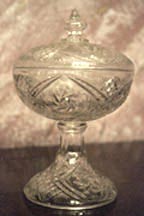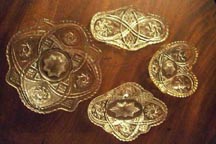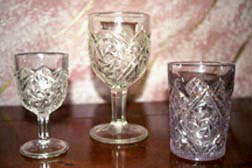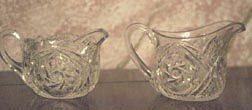

Two different shapes of relish dishes, a condiment tray, and a serving plate.

Showing different styles and
sizes of open compotes.
| Double Pinwheel aka Juno |
| by David W. Whitehorn |
| This pattern
was advertised as "Juno" in 1915, but today most collectors call it Double Pinwheel.
Heacock shows a reproduction of an advertisement for cruets found in the 1905
Butler Brothers catalogue calls the pattern "Heavy Cut." Double Pinwheel apparently was first produced by Beatty-Brady Glass Company in 1898. This glass company joined the National Glass Combine in 1899. When National Glass folded, the molds and patents were sold to Indiana Glass. Indiana Glass had leased the plant from National Glass in 1904 and may have been producing this pattern as early as 1904. It is known that Indiana Glass was producing the pattern after 1915 until about 1920. There are no reproductions of the pattern known. |
 |
 Two different shapes of relish dishes, a condiment tray, and a serving plate. |
| This compote belonged to Lena Pearson Hall of Lincoln County, Tennessee, Great Great Grandmother of the author. |  Showing different styles and sizes of open compotes. |
| Only seen in clear. Gold trim is sometimes used. The Bredehofts and the Sanfords reference an old advertisement in their book which states, "The Juno line, comes decorated in a border of gold, a new honor, I am told, and a flattering one, for tank glass. - January, 1905." |
 |
The design of Double Pinwheel is of a large pinwheel with smaller pinwheels at the end of each spoke. The large pinwheels are separated by an X shaped design. Inside the X (both top and bottom) is a diamond shaped space in a waffle design. To fill in other areas, a fan shaped design is used. |
 |
 |
| The larger compotes and cake stands are not on stems, but are on hollow bases. The goblets, wines, and the very small compote have ribbed stems. | Two different forms of |
| Most open pieces have a shaped rim. The diamond shaped waffle area extends above the rim to form a point. Between these points is a ribbed edge. Double Pinwheel was truly made as a poor man's version of cut glass. In fact, many dealers mistakenly label it as cut. Minnie Kamm says Double Pinwheel is another pattern "in the imitation cut-glass which embraced most of the glass of the Nineties when the popular cut-glass was beyond the pocket-books of most buyer." Alice Metz lists this pattern in a group she calls "IMITATION CUT GLASS GROUP." |
| List of all verified (personally seen) forms with sizes,
any known variations such as multiple sizes, absence or presence of color variations.
Bowl 1" x 4" round Bowl 2" x 6" round Bowl 3" x 7" round Bowl 3" x 8" round Butter dish 5" x 7" Cake stand 4" x 9" Cake stand 4 " x 10 " Celery, 1" x 10" x 4" (oval) Compote, covered 6" x 6" Compote, covered 7" x 7" Compote, open 4" x 4" round Compote, open 7" x 7" round; 8" x 8" round 9" x 7" flared Condiment Tray, 1" x 4" x 8" Creamer (shaped top) 3" x 3", handle to spout 5" Creamer (smooth top) 3" x 3", handle to spout 6" Cruet 6" (with stopper) 5" x 2" Goblet 6" x 3" Pitcher 8" x 4" Pitcher 8" x 4" Tankard type Pitcher, water, footed Plate 1" x 9" Plate 2" x 9" rounded sides Relish 1" x 6" x 8" diamond Relish 1" x 6" x 6" at widest points, heart shaped Salt & Pepper shakers Spooner Sugar, covered; without handles 3" x 4" overall, lid 3" diameter Sugar, open 3" x 4", with applied handles 6" Syrup pitcher Toothpick holder 2" x 2" Tumbler 3" x 2" Wine 4" x 2" |
| References: Bond, Marcella. The Beauty of Albany Glass (1893- 1902). Publishers Printing House, 1972. Bredehoft, Neila, Tom Bredehoft, Jo Sanford, and Bob Sanford. Glass Toothpick Holders. Paducah, Kentucky: Collector Books, 1999. Edwards, Bill, and Mike Carwile. Standard Encyclopedia of Pressed Glass, 1860-1930, Identification and Values. Paducah, Kentucky: Collector Books, 1999. Heacock, William. Encyclopedia of Victorian Colored Pattern Glass, Book 6, Oil Cruets From A to Z. Antique Publications, 1981. Kamm, Minnie Watson. A Fourth Pitcher Book. Privately published, 1946. McCain, Mollie Helen. The Collector's Encyclopedia of Pattern Glass. Paducah, Kentucky: Collector Books, 1983. Metz, Alice Hulett. Early American Pattern Glass. Columbus, Ohio: Spencer-Walker Press, 1958. Unitt, Doris, and Peter Unitt. American and Canadian Goblets. Volume II. For the Love of Glass Publishing Company, Inc. 1994. |
 |
 |
 |